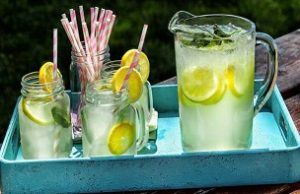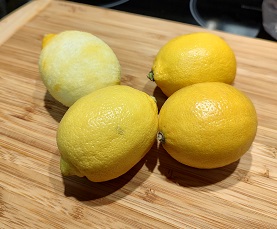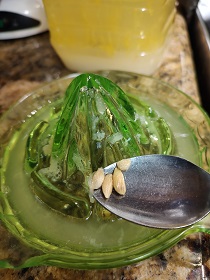Life Giving You Lemons?

Who gave lemons such a bad rap? There may be no more refreshing drink in the summertime than an ice cold lemonade. Thanks to worldwide trade, lemons are available all year round. Florida lemons, though, may be harder to find. If you are fortunate enough to have a healthy lemon tree, or know someone who does, then you are doubly blessed.
6 Florida Lemon Varieties
Currently, there could be over 30 different varieties of lemons. Below, I have listed a small sampling of those lemon varieties which may be commonly encountered in Florida.

- Lisbon Lemons– Thought to have originated in Portugal, these truly are the classic lemonade lemons and are the most common lemons sold in the eastern U. S. They have that distinctive lemon shape with the little “pushed-in” point at one end. Some are seedless, making it easier for me to add the pulp back to my lemonade.
- Harvey Lemon– This lemon has the classic oval shape and tart flavor with almost no seeds.
- Bearss Lemon– The Bearss lemon was developed in Florida in the 1950’s. It is very juicy and possibly has more acid tartness than the Lisbon lemon. Bearss lemon trees are fast growing and bear fruit more quickly than most other varieties. Likewise, Bearss zest has a higher level of lemon oil than other varieties. Making their zest great for baking!
- Meyer Lemon– The Meyer lemon is a hybrid of citron and a mandarin/pomelo hybrid and is not considered a true lemon. They are smaller, more round, and much sweeter than the classic lemon. The zest of this fruit is considered to have more of a bergamot aroma- think “Earl Gray” tea- and its uses lean toward the herbal rather than fruity.
- Ponderosa lemon– Ponderosa is a large lemon fruit which may grow to be grapefruit sized. This tree is a hybrid of a pomelo and a citron. You may only need one ponderosa lemon to make a half-gallon of lemonade, and less sugar. The fruits are tart but not as potent as the classic Lisbon lemon.
- Eureka Lemon – Eureka lemon is close to the classic Lisbon lemon in flavor and aroma and was developed in Italy. Some Eureka Lemon trees sport variegated leaves, striped white and green, with a rind likewise striped green and yellow. Surprisingly, these variegated Eureka lemons have pink pulp-sacks, giving the flesh a pink color. However, their juice is still the color of regular lemon-juice. University of Florida research has developed a greening tolerant Eureka Lemon tree for home citrus culture. SEE homecitrus.ifas.ufl.edu for more information on greening resistant citrus varieties.
When Life Gives You Lemons, Make Florida Lemonade:

Florida Lemonade Recipe
2 quarts (half-gallon) filtered water
1 cup Dixie Crystals sugar
4 Florida lemons, room temperature
Zest of one lemon
- Wash your lemons well and set them aside.
- Into a half-gallon jug, place 2 cups of the water.
- Add the sugar to the water and shake the jug to dissolve the sugar.
- Zest one of the clean lemons. Add the zest to the sugar-water in the jug and shake again.
- Cut all 4 lemons in half on their equator. Twist the lemon halves on a citrus reamer till all the juice is extracted.
- Strain and measure the juice. You should have between ¾ to 1 cup of lemon juice to make a half-gallon. Add the lemon juice into the jug of sugar-zest water.
-

Removing seeds from lemon juice in the citrus-reamer. Photo by Yvonne Florian Fill the pitcher from the remainder of the 2 quarts of water. Shake vigorously till fully combined and all the sugar is dissolved.
- Chill for at least 2 hours. Serve over ice.
Optional: If you like pulp in your lemonade, remove the seeds from the strained pulp and add the pulp
back to the jug.
Gourmet variations:
Florida Limeade– Use Florida limes, if you have them, to replace the lemons in the above recipe at the same measure of juice. Limes are usually smaller than are lemons so you may need 1 or 2 more limes. The zest from one lime is usually enough.
Strawberry Lemonade– slice a pint of strawberries into a medium sized bowl. Add ½ cup of sugar and muddle them together till sugar is dissolved. This is called strawberry simple-syrup. Add a drizzle of vanilla extract to the syrup and stir. Stir 3 tablespoons of strawberry simple syrup and a few strawberry slices into your glass of cold lemonade. You could substitute blueberries, blackberries, raspberries, or mulberries for this berry lemonade.
Watermelon-Lemonade– Mash 3 cups of watermelon chunks in a large bowl. Strain out the seeds and pulp. Chill the watermelon water (juice). Add one half-cup of cold watermelon water to a glass, fill the rest of the way with cold lemonade and ice cubes. This is my new favorite!
Lavender Lemonade– Boil 1 cup water with 1 cups sugar and 1 tablespoon dried culinary lavender. Let cool to room temperature. Strain out the solids. Add 1 tablespoon of this lavender simple syrup to a glass of ice-cold lemonade. The Lavender simple syrup should be refrigerated in a sealed jar and used within a month. Garnish with a lavender sprig from the garden.

Lemon-Limeade– Use ½ cup lime juice and ½ cup lemon juice in the recipe above. The finished product will look just like lemonade. But those bits of green zest in the drink will distinguish it as containing lime.
Electrolyte-Lemonade– This lemonade is ever so slightly salty and should only be used if you are really sweating a lot in the Florida heat. To a half-gallon of homemade lemonade, add ½ teaspoon of Celtic sea-salt or a good Himalayan pink salt. Shake to dissolve the salt. Serve cool but not ice cold. This is a great refresher if you are a landscaper, pool keeper, roofer, farm field hand, or athlete in training and you sweat profusely every day.
Historical Lemon-Lime Trivia:

- Lemons and limes have had many varied uses throughout history
- Citrus juice makes a good marinade for tough cuts of meat
- The ancestors of modern lemons were called citrons and etrogs
- Citrons and etrogs were used medicinally and for celebrations
- The oils from lemon and lime zest may be used as insect repellent
- British sailors took barrels of limes on board long sea voyages to eat to prevent Scurvy, or vitamin C deficiency. They were called “limeys” for this reason. Their heavily pescatarian (fish eaters) diets were deficient in vitamin C.
- A lemon has slightly over twice the amount of vitamin C as a lime
- Lemons & limes may be used interchangeably in most recipes
- Citrus fruit PEELS are being studied as cancer fighters
- In far northern regions, such as Russia and Scandinavia, candied lemon and lime peels are highly prized holiday treats.
However, modern lemon uses lean more toward culinary delights such as Lemon Meringue pie and lemonade. But I like a few thin slices of lemon on my poached salmon. The zest of lemons is a wonderfully flavorful additive to home baked muffins, quick-breads, and cookie recipes. I’ve even made my own lemon-pepper seasoning with fresh lemon zest for a meat rub for grilling or on baked lemon-pepper chicken. The leaves of lemon and lime trees are sometimes used as an herbal seasoning or for tea.
As a handy switch, lemon juice may replace vinegar in homemade salad dressings. Additionally, when I am tired of drinking plain water, I will slip a wide curl of citrus zest into my water glass for the day to infuse the water with a hint of flavor. And on a healthy note, new research is showing citrus peels to have anti-cancer properties.
Growing Your Own Citrus
If you would like to grow your own citrus trees, the University of Florida’s “homecitrus” website is the first place to start. This research-based program can walk you through soil preparation, tree selection, grower nurseries, fertilizer and insecticide regimens, insect scouting, and irrigation.
Citrus Greening Disease
Citrus greening disease, or HLB (Huanglongbing) is a very real and tragic problem for citrus producers and home fruit hobbyists. Following my theme, I would like to introduce the University of Florida’s Greening Tolerant Eureka Lemon tree. If you are shopping for a new citrus tree, be sure to check out the list of nurseries on the “homecitrus” website which can supply the new Greening Tolerant varieties of citrus trees.
Want to learn more about growing and caring for your citrus trees? The IF/IFAS EDIS (University of Florida’s Institute of Food and Agricultural Sciences Electronic Data Information Source) publication, “Citrus Culture in the Home Landscape” has that information.
 3
3

